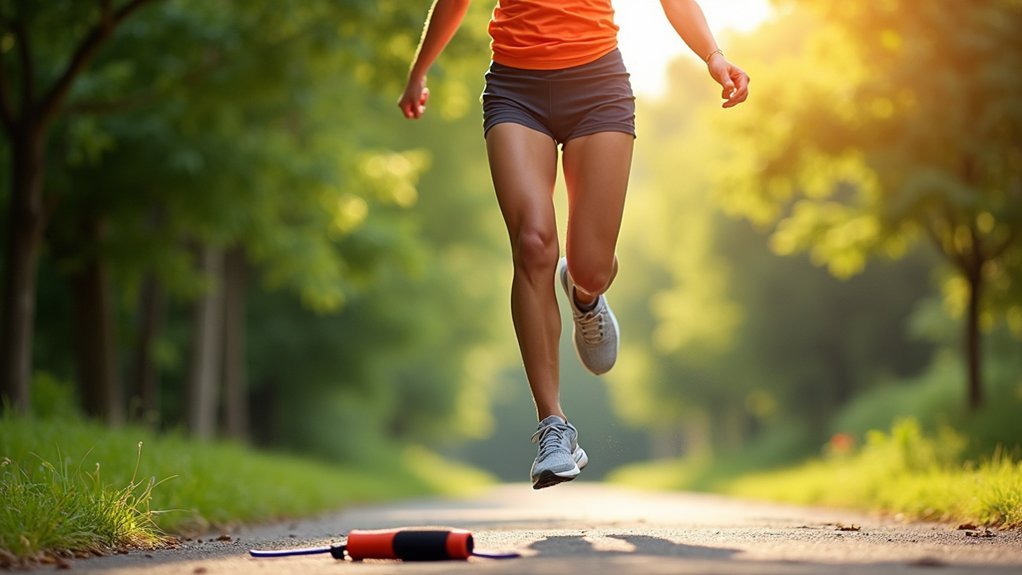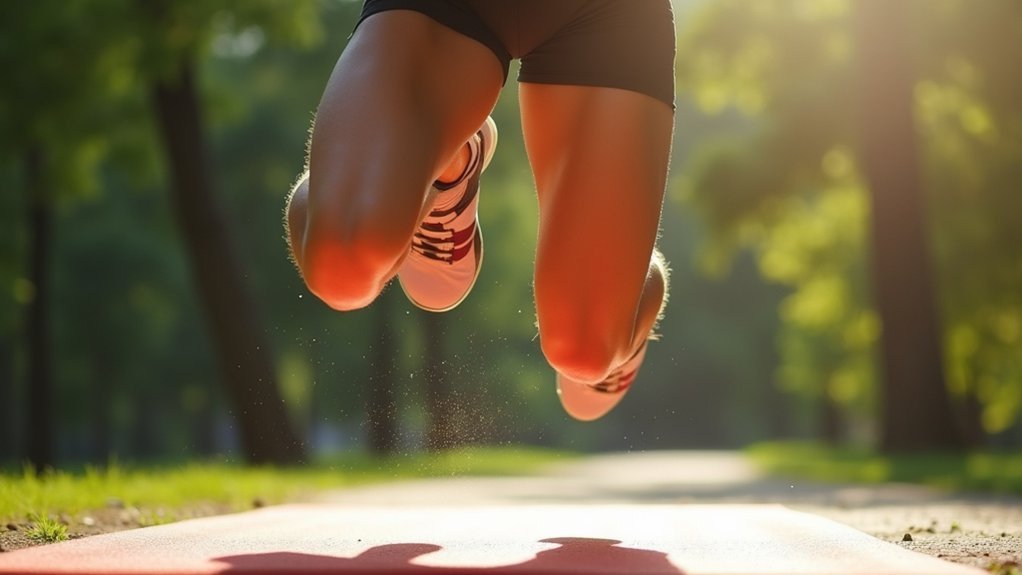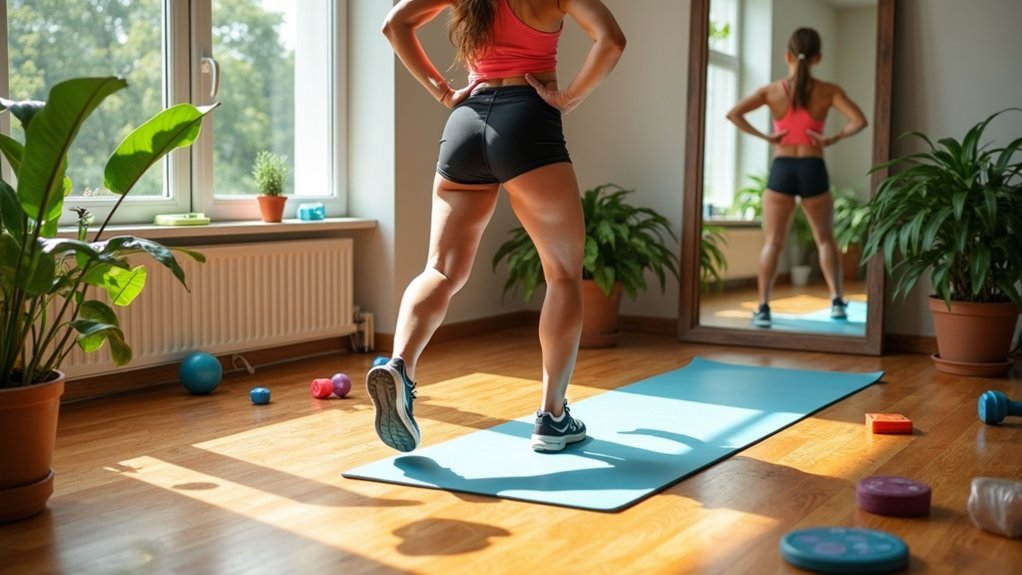Mini-trampoline workouts effectively target cellulite by boosting lymphatic flow, improving circulation, and engaging multiple muscle groups simultaneously. Start with a quality rebounder, proper space, and a 10-minute daily routine combining gentle bounces and targeted movements like knee raises and twist jumps. Add high-intensity intervals three times weekly to maximize fat burning. Stay hydrated before sessions and focus on anti-inflammatory foods post-workout. These science-backed techniques offer a joint-friendly approach to smoother, firmer skin.
7 Tips: Mini-Jump Workouts for Cellulite Reduction

While many people struggle with cellulite, mini-jump workouts offer an effective solution that targets this common concern.
These exercises strengthen multiple muscle groups in your legs, hips, and thighs while improving circulation—key factors in reducing cellulite’s appearance.
Start with just 10 minutes daily of gentle bounces, gradually increasing intensity as your fitness improves. Incorporate various jump styles to keep your routine engaging and target different muscle groups. For maximum effectiveness, use upbeat music to stay motivated. These rebounding exercises also enhance your overall health by increasing lymphatic flow, which helps detoxify the body and reduce fluid retention that contributes to cellulite.
Mini-jumps deliver impressive benefits beyond cellulite reduction. You’ll burn calories, boost metabolism, and improve cardiovascular health—all while enjoying a low-impact workout that’s gentle on your joints.
The enhanced blood flow will supply oxygen to your skin, promoting a healthier, more even-toned appearance.
The Science Behind Rebounding and Cellulite Reduction
Although cellulite affects people of all sizes, the science behind rebounding offers promising solutions for those seeking to reduce its appearance.
Rebounding works by stimulating your lymphatic system, which plays an essential role in removing toxins from your body. As you bounce, the gentle gravitational changes help pump lymphatic fluid throughout your system.
This mini-jumping exercise improves blood circulation to skin tissues, effectively reducing the dimpled appearance caused by fat cells pushing through connective tissue. Your body benefits from both the cardiovascular workout and the enhanced lymph flow.
Studies show rebounding can decrease body fat percentage while toning leg and glute muscles that support skin structure. The low-impact nature of this exercise makes it accessible while still engaging your entire body in the fight against cellulite.
Getting Started: Equipment and Space Requirements

Three essential pieces of equipment are needed to begin your cellulite-reducing rebounding journey. First, you’ll need a quality mini trampoline with proper weight capacity for your body.
Starting your rebounding journey requires the right mini trampoline—one that supports your weight and jumpstarts your cellulite-reduction goals.
Second, place a non-slip mat underneath to prevent movement during intense sessions. Finally, a sturdy chair or wall nearby provides balance support when you’re learning new movements.
For best results, create a dedicated rebounding space that includes:
- A minimum 6×6 ft area allowing full movement range
- Sufficient ceiling height (at least 1-2 ft above your head when jumping)
- Hard, non-carpeted flooring for stability
- Good ventilation to prevent overheating during workouts
- A water bottle within reach for necessary hydration
Don’t worry about breaking the bank—affordable options include used rebounders or foldable models under $100.
Beginner’s Protocol: 10-Minute Daily Circulation Boosters
Starting your mini-jump journey doesn’t require hours of exhausting exercise. Just 10 minutes daily on your mini-trampoline can boost circulation and reduce cellulite appearance.
Begin with a 1-minute warm-up of gentle toe taps. Then perform 3 minutes of basic mini-jumps, focusing on maintaining consistent movement.
Next, add 2 minutes of deep knee bends while jumping to target thighs and glutes. Follow with 2 minutes of high knee raises to intensify muscle engagement.
Finish with a 2-minute cooldown of gradually decreasing jumps.
Stay hydrated and eat whole foods to enhance results. Track your progress with photos and adjust intensity as needed.
You’ll likely notice increased urination post-workout—a sign that detoxification is happening as your circulation improves. The trampoline’s rebounding effect creates hypergravity conditions that effectively compress veins and lymphatic vessels to improve drainage.
High-Intensity Interval Techniques for Maximum Fat Burning

Once you’ve built a foundation with the beginner’s protocol, it’s time to ramp up your results with high-intensity interval training (HIIT) on your mini-trampoline.
These powerful bursts of activity maximize fat burning while preserving muscle mass—crucial for fighting cellulite.
HIIT stimulates your metabolism long after you’ve finished jumping, thanks to the EPOC effect that keeps your body burning calories for up to 24 hours post-workout.
- Alternate 30 seconds of maximum-effort jumps with 15 seconds of recovery
- Aim for just 10-20 minutes per session—quality trumps quantity
- Incorporate varied movements like high knees, twist jumps, and squat jumps
- Perform these workouts 2-3 times weekly for ideal results
- Always include proper warm-up and cool-down routines to prevent injury
Targeted Rebounding Moves for Thighs, Hips and Buttocks
You’ll get faster results targeting cellulite with these three essential mini-trampoline techniques.
Start with basic bounce variations that engage thigh muscles directly, then advance to twisting jump sequences for thorough hip engagement.
For maximum glute activation, incorporate single-leg balance work that challenges stability while toning problem areas.
Basic Bounce Variations
While traditional rebounding offers full-body benefits, targeted variations can intensify the cellulite-fighting effects specifically for your lower body trouble zones.
These basic bounce variations leverage HIIT principles to maximize both mechanical stimulation and metabolic impact on cellulite-prone areas.
- Heel Lifts – Alternate lifting heels while maintaining a gentle bounce to engage posterior leg muscles
- Wide Stance Bounce – Jump with feet shoulder-width apart to target outer thighs and hips
- Tuck Jumps – Pull knees toward chest during upward movement for increased gluteal engagement
- Scissor Jumps – Alternate legs forward and back while bouncing to work multiple muscle groups
- Pulsing Squats – Combine shallow squat position with small, controlled bounces to intensify thigh work
You’ll feel these targeted variations working immediately as they boost circulation to stubborn areas. Regular practice can help tone muscles in the buttocks and thighs where orange-peel skin commonly appears.
Twisting Jump Sequences
Twisting jump sequences represent a crucial evolution in cellulite-targeting rebounding workouts, combining rotational force with vertical momentum to create multidimensional muscle engagement.
These movements specifically activate your obliques and lateral thigh muscles while enhancing lymphatic flow through torso-leg drainage pathways.
Start with 30-second alternating side-to-side twists that stimulate groin lymph nodes, followed by 15-second isometric holds.
Progress from basic bounces to 90° and 180° rotations to prevent movement accommodation.
Try diagonal jumps with torso twists to activate your gluteus medius, and add pendulum arm swings for increased core resistance.
For maximum benefit, wear compression leggings to enhance thermogenic effects and use textured rebounding surfaces for better proprioceptive feedback.
These low-impact torsion movements effectively reduce fascial adhesions while minimizing joint stress.
Single-Leg Balance Work
Single-leg balance work represents the cornerstone of targeted cellulite reduction on a rebounder, engaging deep stabilizer muscles that often remain dormant during conventional exercises.
You’ll maximize results by focusing on controlled, quality movements rather than quantity.
- Start with 10-15 single-leg hops, keeping your knees soft to protect joints while activating lymphatic drainage.
- Add lateral shifts to target outer thighs and saddlebag areas—hinge slightly at the hips to engage glutes fully.
- Incorporate toe-tap drills at varying speeds to challenge proprioception in cellulite-prone regions.
- Progress to dynamic leg switches mid-air after mastering basic balance, maintaining forward gaze.
- Try 30-second high-intensity intervals with 30-second rest periods to boost post-workout fat oxidation.
For best results, perform 3-4 sets, 2-3 times weekly, paired with proper hydration.
Complementary Hydration and Nutrition Strategies
The success of your mini-jump workouts hinges considerably on your hydration and nutrition choices before, during, and after exercise.
You’ll want to follow a pre-jump hydration protocol that includes drinking 16-20 ounces of water about two hours before rebounding, ensuring your muscles and skin remain properly nourished.
Complement your rebounding routine with anti-inflammatory foods like berries, leafy greens, and omega-3-rich fish that work synergistically with your workout to reduce cellulite appearance.
Pre-Jump Hydration Protocol
While exercising, maintaining proper hydration isn’t just beneficial—it’s essential for peak performance and cellulite reduction results. Your pre-jump hydration routine can greatly impact your workout effectiveness.
- Start your day with a full glass of water to rehydrate after sleep.
- Drink water 15-30 minutes before your mini-jump workout to guarantee ideal hydration.
- For longer sessions, sip water every 10-20 minutes to maintain performance.
- Monitor your hydration status by checking urine color—aim for pale yellow.
- Consider consulting a dietitian for a personalized hydration plan based on your specific needs.
Remember that both under and overhydration can impair your performance.
Women should aim for 2-3 liters daily, while men need 3-4 liters. Adjust your intake based on workout intensity and environmental conditions.
Post-Workout Recovery Nutrition
After completing your mini-jump workout, proper nutritional choices become just as important as the exercise itself for reducing cellulite. Focus on consuming protein within 30 minutes post-workout to support muscle repair while balancing it with complex carbohydrates to restore energy levels.
| Nutrient | Function | Food Sources |
|---|---|---|
| Protein | Muscle repair | Chicken, eggs, tofu |
| Complex Carbs | Energy restoration | Sweet potatoes, oats |
| Healthy Fats | Skin elasticity | Avocados, nuts |
| Antioxidants | Reduce inflammation | Berries, dark greens |
| Electrolytes | Rehydration | Coconut water, bananas |
Don’t forget to maintain a balanced caloric intake that supports fat loss while providing enough nutrients. Timing matters—your post-jump meal window is essential for maximizing recovery benefits and enhancing cellulite reduction efforts.
Anti-Inflammatory Food Pairings
Combining the right foods after your mini-jump workout can dramatically enhance your body’s anti-inflammatory response, directly impacting cellulite reduction efforts.
These strategic pairings optimize nutrient absorption and amplify your body’s natural detoxification processes.
- Pair fatty fish (salmon, mackerel) with leafy greens to combine omega-3s with vitamin K, reducing inflammation markers while supporting skin elasticity.
- Blend antioxidant-rich berries with nuts—try blueberries with walnuts to decrease pro-inflammatory cytokines.
- Serve cruciferous vegetables with healthy fats; broccoli with olive oil activates the Nrf2 pathway for enhanced detoxification.
- Hydrate with turmeric-black pepper tea for 2000% increased curcumin absorption to target joint inflammation.
- Include pigment-dense fruits with fermented foods like cherries and kefir to enhance gut-skin communication.
Frequently Asked Questions
Can Rebounding Worsen Varicose Veins or Spider Veins?
Rebounding generally doesn’t worsen varicose or spider veins. In fact, it’s often beneficial as it improves circulation and strengthens vein walls. However, if you have severe venous insufficiency, consult your doctor first.
How Does Rebounding Compare to Vibration Plates for Cellulite Reduction?
Rebounding offers superior cellulite reduction through active lymphatic circulation and fat burning, while vibration plates provide passive benefits. You’ll likely see faster results with rebounding’s whole-body approach compared to vibration’s localized effects.
Will Rebounding Results Last if I Stop Exercising Regularly?
No, your rebounding results won’t last if you stop exercising regularly. You’ll experience reduced circulation, lymphatic stagnation, muscle atrophy, and metabolic slowdown, causing cellulite to gradually return. Occasional maintenance sessions help preserve some benefits.
Can I Rebound Safely During Menstruation or Pregnancy?
During menstruation, you can rebound gently after initial days when you feel comfortable. Start with 30-60 second sessions. For pregnancy, always consult your doctor first—it’s generally not recommended due to joint laxity and pelvic floor considerations.
Does Body Weight Affect the Rebounding Results for Cellulite Reduction?
Yes, your body weight impacts rebounding results. If you’re overweight, you’ll likely see more dramatic cellulite reduction as you lose weight, but muscle toning benefits work for everyone regardless of size.
In Summary
You’ve now got all the tools you need to combat cellulite through mini-jump workouts. Remember, consistency is key—even short 10-minute sessions make a difference when done regularly. Combine your rebounding routine with proper hydration and nutrition for best results. Don’t expect overnight changes, but with patience and persistence, you’ll see firmer, smoother skin emerge. Start small, stay committed, and enjoy the bounce!





Leave a Reply